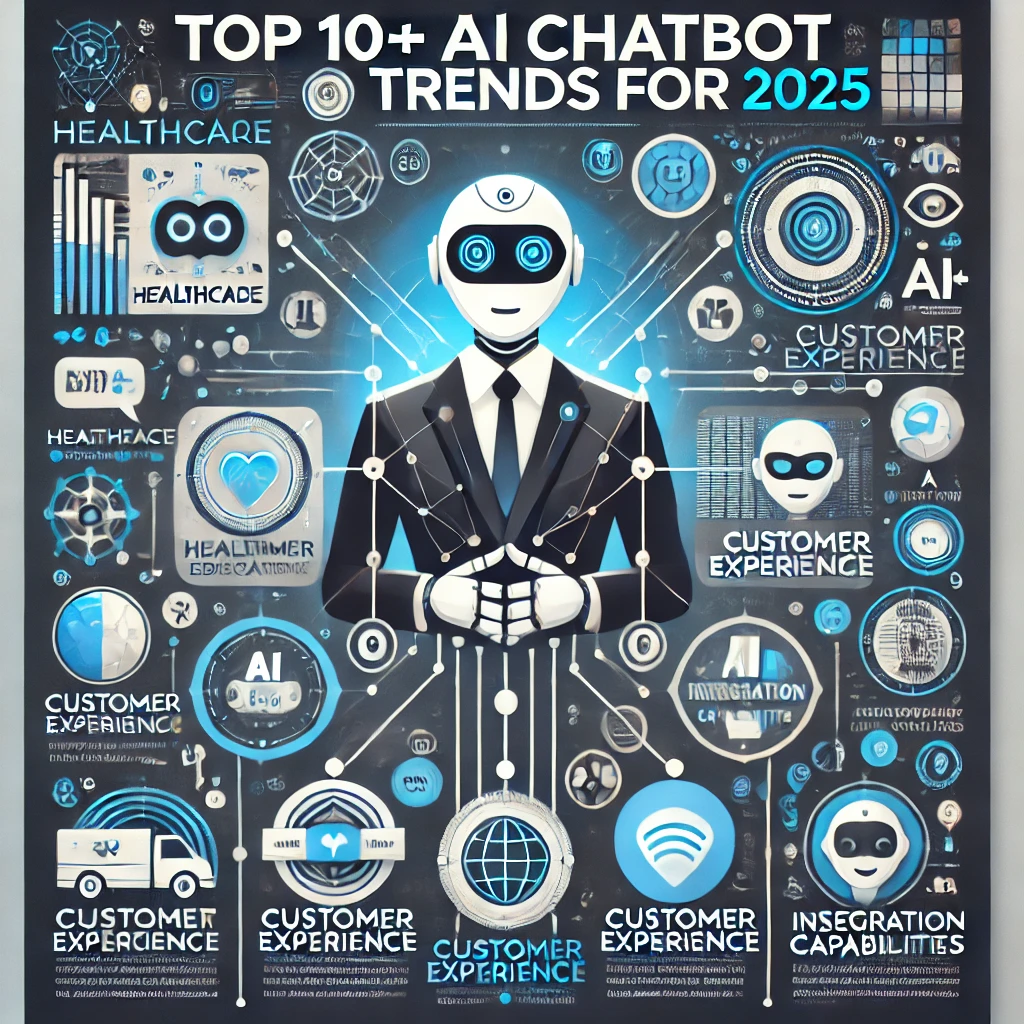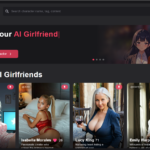
Top 10+ AI Chatbot Trends for 2025
The AI chatbot industry continues to evolve rapidly, and with new technological advancements, businesses are adapting their strategies to align with these changes. From AI-driven personalization to emotionally intelligent interactions and specialized applications, chatbots are becoming vital across numerous sectors.
Table Of Content
- List of Top 10+ AI Chatbot Trends for 2025
- 1. Traditional Chatbots
- 2. AI Driven Personalization
- 3. Chatbots in Education
- 4. Enhanced Customer Experience
- 5. Emotionally Intelligent Chatbots
- 6. Adoption of AI
- 7. Custom AI Models for Businesses
- 8. Chatbots in Healthcare
- 9. More Chatbot Apps
- 10. Enhanced Integration Capabilities
- 11. Use of AI in Contact Centers
- 12. Specialized Chatbots
- Final Thoughts
With the year 2025 on the horizon, here are the key trends that will shape the AI chatbot market in the upcoming years.
List of Top 10+ AI Chatbot Trends for 2025
1. Traditional Chatbots
2. AI Driven Personalization
3. Chatbots in Education
4. Enhanced Customer Experience
5. Emotionally Intelligent Chatbots
6. Adoption of AI
7. Custom AI Models for Businesses
8. Chatbots in Healthcare
9. More Chatbot Apps
10. Enhanced Integration Capabilities
11. Use of AI in Contact Centers
12. Specialized Chatbots
Now, I will show you the detailed guide for all these Top 10+ AI Chatbot Trends for 2025 in the below post.
1. Traditional Chatbots
Traditional chatbots have been part of digital communication for a long time. These bots function based on pre-defined scripts and decision trees, performing specific, repetitive tasks effectively. Many businesses still rely on these bots to answer FAQs, provide store hours, or direct users to the correct department.
In comparison to AI-powered chatbots, traditional bots lack advanced features like machine learning capabilities or emotional intelligence. However, they still hold value because of their simplicity and reliability in handling straightforward, rule-based tasks. Many companies prefer using traditional chatbots for predictable interactions, especially for businesses with repetitive and standardized inquiries.
2. AI Driven Personalization
AI-driven personalization is one of the most significant trends shaping chatbot technology. These chatbots analyze user preferences, behavior, and past interactions to tailor responses and recommendations.
For instance, a chatbot on an e-commerce website can suggest products based on a user’s purchase history, while a streaming platform bot might recommend movies and shows according to viewing habits. Similarly, banks and financial services use personalized AI responses to offer financial advice or notify users about account activity.
By focusing on personalized experiences, businesses can improve user satisfaction and strengthen customer relationships.
3. Chatbots in Education
The role of AI chatbots in education is becoming more prominent. Educational institutions are adopting AI to simplify administrative tasks and create interactive learning environments for students.
For example, students can use AI-powered chatbots to ask questions about lessons, receive explanations, or access study guides. Likewise, educators rely on these bots to manage administrative duties such as grading, attendance tracking, and course management.
Chatbots are revolutionizing the way information is accessed and shared in schools and higher education institutions, making them more accessible and efficient for both students and teachers.
4. Enhanced Customer Experience
Customer experience has become a critical focus for businesses, and AI chatbots are at the forefront of this trend. With their ability to provide quick, personalized, and seamless support, they are transforming how users interact with brands.
AI face swap is an example of how chatbots are creating more interactive and personalized experiences. These visual technologies are making their way into industries like retail and fashion, allowing users to virtually try on products and visualize options before making purchases.
Through these advanced features, businesses can offer a seamless user journey, reducing wait times, analyzing customer feedback, and increasing customer satisfaction.
5. Emotionally Intelligent Chatbots
Emotionally intelligent chatbots represent an exciting trend, as they aim to create human-like conversations by analyzing user emotions. These bots can detect frustration, happiness, confusion, or anger based on word choice and tone, allowing them to respond empathetically.
These chatbots are being used in a variety of industries, including healthcare, mental health, and customer service. For instance, an emotionally intelligent chatbot can offer support to a customer struggling with a delayed shipment or provide comfort to a patient with health concerns.
Despite the potential benefits, building emotionally intelligent AI comes with challenges, such as ensuring accurate emotion recognition and maintaining ethical AI standards.
6. Adoption of AI
The adoption of AI in business operations continues to grow. Businesses are implementing AI-powered chatbots to handle everything from customer inquiries to supply chain management. AI simplifies time-consuming processes, offers data-driven insights, and minimizes the need for excessive human intervention.
We are seeing this trend across industries like finance, retail, healthcare, and telecommunications. These industries rely on AI chatbots to provide instant support and handle large volumes of customer interactions efficiently.
AI adoption allows businesses to respond faster to customer needs and streamline operations, saving time and costs simultaneously.
7. Custom AI Models for Businesses
AI models are becoming more tailored to meet the unique needs of individual businesses. Custom AI models are trained with industry-specific data to solve unique challenges.
For instance, a law firm might use a custom AI chatbot trained in legal terminology to assist with client inquiries. Similarly, a real estate company can deploy a custom chatbot to streamline property searches and assist clients with real-time information on listings.
These specialized models show how businesses can optimize AI technology by focusing on their unique goals and operations.
8. Chatbots in Healthcare
AI chatbots are revolutionizing the healthcare industry by providing accessible solutions for both patients and medical professionals. These bots assist with symptom checking, medical information, appointment scheduling, and medication reminders.
For example, a chatbot can guide a user through common symptoms and recommend seeking appropriate care when necessary. Likewise, patients can use AI-powered tools to manage schedules, set reminders for medications, and receive mental health support.
The integration of chatbots into healthcare reduces the burden on medical staff while improving accessibility for users. However, ensuring the accuracy of medical information remains vital as errors could have serious consequences.
9. More Chatbot Apps
The number of chatbot apps continues to grow, driven by the demand for instant and on-demand services. These apps are now being deployed across fitness, finance, travel, and other industries.
Chatbot apps streamline tasks such as planning trips, managing workouts, tracking finances, and checking health statistics. These applications have proven effective by creating user-friendly interactions and improving efficiency.
Businesses recognize the need to integrate chatbots into mobile apps to meet customer expectations, creating new opportunities for innovation.
10. Enhanced Integration Capabilities
Integration with existing systems is essential for the success of AI chatbots, and this trend is becoming more common as businesses strive for seamless operations. Modern AI chatbots integrate with CRM, ERP, and other backend systems, pulling real-time data to improve decision-making and customer support.
For instance, a chatbot connected to CRM tools can access a user’s purchase history to offer better recommendations. Similarly, bots integrated with supply chain networks can provide timely updates on delivery tracking.
Such integrations allow chatbots to access accurate, real-time insights, thereby improving business operations and customer interactions.
11. Use of AI in Contact Centers
AI is being widely adopted by contact centers to handle customer inquiries and reduce response times. AI-powered chatbots are managing common requests like password resets, order inquiries, or technical troubleshooting. This reduces the burden on human agents and allows them to focus on more complex tasks.
With AI, contact centers are becoming more efficient while maintaining high levels of user satisfaction. These systems can handle thousands of interactions simultaneously, improving response rates and operational costs.
12. Specialized Chatbots
Businesses are increasingly focusing on creating specialized chatbots trained to meet specific industry needs. Using platforms like all AI tool directories, companies are building these bots to optimize workflows across industries.
Specialized chatbots are being deployed in industries such as finance, real estate, legal services, and retail. These AI tools provide tailored solutions, streamline tasks, and ensure that users receive accurate, industry-specific information.
Final Thoughts
The trends listed above indicate that AI chatbots are set to redefine industries in numerous ways by 2025. From emotionally intelligent interactions to personalized recommendations and specialized AI models, chatbots are becoming more efficient, accessible, and innovative. Businesses that stay on top of these trends will likely experience better customer engagement, streamlined operations, and improved user satisfaction.
The AI chatbot market will only continue to grow as companies adopt new strategies to implement these trends. As they evolve, chatbots will maintain their role as pivotal tools in customer service, healthcare, education, and other sectors.





